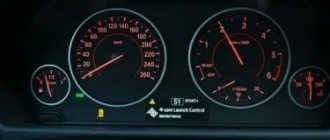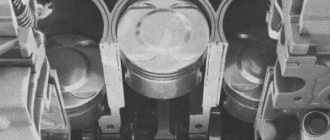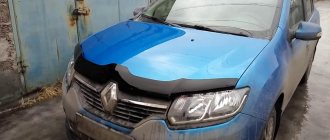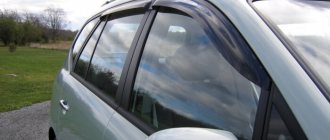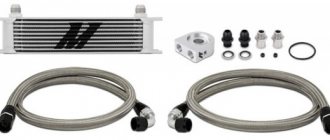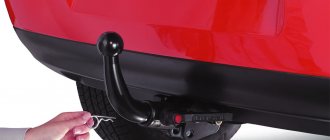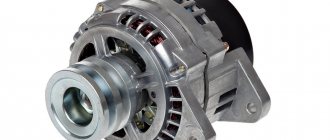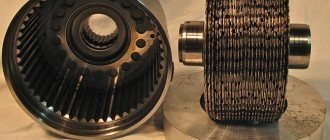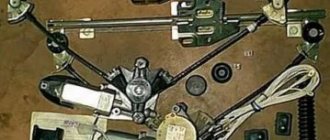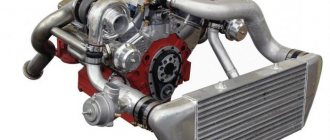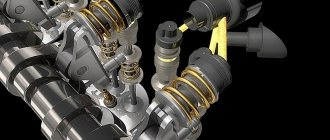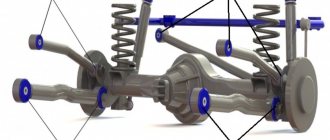Mobile homemade slipway
This is the kind of slipway our forum member Evsey made.
The design of the lightweight and mobile Finnish slipway Autorobot micro A was taken as the basis.
The main materials used in the manufacture of steel were channel No. 10 and No. 12.
Below in the photo are the main components of the slipway.
- Swivel lock
Swivel lock
- Cross member
Cross member
- Cross member
Cross member
- Power tower
Power tower
View the embedded image gallery online at:
An important detail of the slipway is the sill grips, a kind of vise. For their manufacture, sheet steel 16 mm thick was used. The width of the sill grips is 150 mm, the tightening bolts are 12, and the bushings are 14 mm. The springs were used from the valves of the classic VAZ. The “jaws” of the grips are made of metal rasp.
To work with this slipway, hydraulics from the kit are used, designed for 10 tons. This is the chain clamp located on the draft tower (boom) of the slipway, and also how the sill grips work.
Slipway in operation:
- Slipway at work
Slipway at work
- Slipway at work
Slipway at work
- Slipway at work
Slipway at work
- Slipway at work
Slipway at work
View the embedded image gallery online at:
And here is the actual diagram with the dimensions of the slipway.
To simplify the work, special stands were welded with the car driving onto them from the front or back, and it became easier and also much faster to bring the slipway under the belly of the car.
- Bridges
Bridges
- Slipway at work
Slipway at work
- Slipway at work
Slipway at work
- Slipway at work
Slipway at work
View the embedded image gallery online at:
This design of the slipway has the ability to install a device to pull down. To do this, you need to modernize it a little by placing a sliding roller under the chain links.
Pros and cons of this do-it-yourself slipway design. It may be worth taking them into account if you repeat this or a similar design.
Cons and improvements:
- There are only two sill grips and no height adjustment.
- Lock for turning the boom horizontally: there was 5 mm iron, a minimum of 10-15 mm was needed.
- During operation, weak points began to emerge and were strengthened.
- The length of the telescopic boom is, in principle, excessive, so it can be made shorter.
- How to hook a car to the sills from below with these grips if they do not have flanges, for example, a BMW type car? To do this, you will need special adapters, which cost quite a bit of money (there are homemade options).
Pros:
The mobility of the slipway and the ability to turn it in different directions can be considered both a plus and a minus, but in a small garage there will be a problem with movements. On the other hand, not every car repair requires the use of a slipway, and in this case it can simply be rolled out of the garage. And for a small garage it will be more practical to make a stationary slipway (we’ll talk about it a little later).
General impressions of Evsey (the author of the project) from working with his slipway:
In general, it’s beautiful, the car stands dead on the slipway, the hydraulics pull extremely easily, as if you weren’t pulling iron, but cardboard or paper. Before this I used a regular winch, so I can compare and say that this is heaven and earth. Stapel has proven himself to be a real hard worker, his rating is 5 plus, he is very mobile and reliable.
You can read details and discussion of this design on our forum here.
As one of the options for a small homemade slipway for use in the garage, below is the video from Boris AvtoDok, where he talks in detail about his design.
In the second video, errors identified during work, how he corrected them and what modifications he made.
What is a body slipway, why is it needed and how does it work?
If it is necessary to carry out body repairs, it can be divided into small and large.
Minor work includes restoration of paintwork, removal of small scratches and dents. Under the right circumstances, most of this type of work can be done yourself.
Carrying out major body repairs involves completely different concepts. It should be done in situations where there has been an accident, an accident, which results in a violation of the geometry of the body. Using an ordinary hammer, such a malfunction cannot be eliminated. Carrying them out requires the presence of special straightening equipment, a special place in which is occupied by a slipway or simply a straightening stand.
Carrying out repairs requires special straightening equipment, a special place in which is occupied by a slipway or simply a straightening stand.
With the help of such installations it is possible to return the body to its previous condition in a short time. Slipways are almost never used in garages, but they are available at service stations or car repair shops.
At the same time, car owners should understand exactly how the stocks are structured, what they can be, and how this or that type of straightening stand can cope with the resulting violation of the geometry of the car body.
What is a slipway? This is a device used to restore damaged body geometry. Mainly, the stocks are equipped with a hydraulic power unit, the task of which is to create a large force aimed at correcting the body geometry after an accident or accident. At the same time, specialized devices can cope with even very serious damage.
A straightening stand is needed in order to carry out complex body repairs and correct broken geometry. It contains a large number of tools and devices. All of them pursue a single goal, namely, the restoration of the original body shape. The main components are:
- Various grips;
- Chains;
- Measuring instruments;
- Spotters and more.
The design of many components makes it possible not only to exert a force on the metal of the body, but also to dose the forces with load distribution, with a strong grip on the metal and measurement of current parameters. After all, you can easily overdo it, and then it will be impossible to restore.
Principle of operation. Mainly, the use of slipways or straightening stands is carried out with automobile transport. During the process, the body of a car involved in an accident can be corrected, resulting in various dents or defects. Using a slipway, you can stretch out the car body and give it its factory shape.
Using a slipway, you can stretch out the car body and give it its factory shape.
To understand the essence and all the features of the slipway, you need to familiarize yourself with the principle of its operation:
- Before carrying out work, specialists conduct an inspection and draw up a list of required measures;
- After completing the preliminary diagnostics, the machine is placed on a special platform, firmly fixed in the frame for subsequent pulling;
- Using the grips, chains and measuring instruments provided on the straightening stand, the area where the work will be carried out is determined;
- A force controlled by the operator is created on the slipway. The device can stretch or compress metal in different directions, creating the possibility of returning to its previous shape;
- The structure of the metal itself receives almost no damage.
Slipways can be rolling, floor, frame and platform.
Without a slipway, it is most likely impossible to straighten in one moment
Conclusion. The extent to which this type of installation is beneficial in a home environment is a controversial issue. But every self-respecting auto repair shop that provides car repair services should have it, and it should be professional and of high quality.
What is needed to make a slipway
The production of slipways is carried out by large world-famous companies and small regional enterprises. The price of such power stands varies greatly, but making such equipment yourself will cost many times less. Depending on the chosen design, drawings should be drawn up, providing for all the features of the future workshop. Then all that remains is to prepare the necessary consumables and tools.
To assemble a homemade slipway you will need a metal profile, which will form the skeleton of the structure. The assembly process is carried out by welding and the appropriate equipment must be available
The fastening system is developed individually and it is important to purchase a power rack mechanism, chains and gripping devices that are difficult to manufacture. Before starting work, you should prepare the metal by cleaning it from rust, degreasing and priming. After which you can begin assembling the structure
After which you can begin assembling the structure.
Slipway.
Jig for welding motorcycle frames.
When making or altering a motorcycle, any beginning customizer very often faces the problem of properly assembling and welding the base of any motorcycle—the frame (I advise you to read about frames here), and we will educate you about altering frames here. It is from the frame that the entire geometry of the motorcycle, strength and controllability, as well as the silhouette and design “dance”. Even if a fragment of the frame is partially removed (during alteration), for example, by cutting out a part of a pipe, immediately after this the geometry of the frame changes, albeit not significantly, and loses its original shape specified during welding.
When making a frame from scratch, it is practically impossible to correctly align all the elements, grab, weld and maintain the correct geometry without rigid and verified fixation of all elements and parts of the frame. It is for these purposes that the slipway exists. There are many options for manufacturing slipways, but the main parameters that a slipway should have are its accuracy and rigidity, since during welding the metal heats up and therefore changes shape.
Our task is to maintain the geometry and symmetry of the frame during assembly and welding, and the loss of the set exact shape (geometry and symmetry) should be minimized. Therefore, ideally, the base of the slipway should be flat and massive, such as, for example, a milling machine table with a dividing head (for securing the steering column) or a lapping plate. But not everyone succeeds in getting them, so there is a simpler option: you can make a slipway from a profile pipe with a square section of 80x100mm or 100x100mm.
Choose a pipe wall thickness of at least 8 mm, or better yet, even thicker. You will need two main pipes no more than two meters in length, and pipes for the stands, the length depending on your height or desire to work standing or sitting. You can make these stands of variable height (on the principle of a telescope - a pipe in a pipe), but I think the best option is stands with a powerful rotating device (on powerful axes), which allows you to rotate the frame around these axes and will allow you to carry out welding work more conveniently and efficiently .
It is advisable to fasten the main pipes on which the frame will be placed to each other not by welding, but by using stepped plates and bolts or nuts (as shown in the photo on the left or in the photo on the bottom left), or as shown in the video below the article. This will allow, firstly, to make a slipway to fit any frame width (we’ll find out how to expand the rear part of the frame here), it will be enough to change the plates to wider ones, and secondly, it will guarantee that the base of the slipway will not move, as usually happens when welding.
When the main pipes are accurately and evenly clamped by the plates and secured to the racks, you can begin to secure the steering column holder. As I already said, ideally the steering column holder is a dividing head, but if you can’t get it, I’ll advise you to make a device, which I managed to make in a couple of days (see photo).
The base of the holder is the front fork of domestic heavy motorcycles (the cheapest option), on one of the traverses of this fork the steering column holder with two cones is attached. The system allows, when bringing the steering column to the front duplex of the frame, to immediately see and select the angle of inclination of the steering column, since when the cones are tilted, the arrow moves relative to the fixed protractor (protractor)
The slotted plates are made from sheet metal 10 mm thick, but thicker is possible. The crossbars naturally move up and down if desired, thanks to this you can make a hynek (a very high front part of the frame) of any height. The most important thing when attaching the holder to the base is to secure it strictly at a right (90 degrees) angle in both planes (when viewed from the side and when viewed from the front).
The steering column holder can also be made from a square pipe with a groove in the middle, in which a threaded axis with cones is fixed and moves up and down. There are several options, it's up to you to choose.
Having secured the steering column holder, all that remains is to make prisms for clamping the lower frame tubes, a holder for the upper frame tube (which is under the tank), a pendulum holder and a rear wheel axle holder (see diagram in the figure). All these devices are made of square pipes according to the principle of a pipe in a pipe (telescope), this allows you to change the height of the mounts.
Naturally, all these holders are attached strictly in the middle of the slipway and are made on slides (longitudinal grooves) so that they can be moved and clamped in the longitudinal direction. The main thing in all these devices, as I already said, is accuracy and rigidity. If anyone is interested in reading about a car slipway, click on this link. Good luck to everyone!
If this article is useful to you, please share it on social media. networks by clicking the buttons below. Thank you.
RќСЂР°РІРёС‚СЃСЏ
Completion of manufacturing work
When making a slipway with your own hands, you need to remember that for better grip you will need to make special notches or weld nuts on the racks. To fasten frame elements, it is necessary to use nuts and bolts with fine threads. At the same time, experienced car enthusiasts advise taking such fasteners from repair kits from foreign cars.
When working with hydraulics with a capacity of about four tons, it is worth using M10 bolts. They allow you to clearly fix the racks on the beam and subsequently withstand the specified load.
After installing the device, be sure to paint it to protect it from corrosion, since it will be installed in a room with high humidity. To do this, you need to clean the metal from rust and coat it with a primer. After this, you should paint the frame using a spray gun.
After painting, the frame is mounted at the place of use. The installation site must be prepared in advance, and if you plan to carry out a wider range of body work, it makes sense to manufacture and install another homemade slipway mounted on a rotary column.
No matter how talented you are, hands alone will not be enough to straighten the body; special devices are needed here. In order to properly restore the body after an accident, you cannot do without a slipway.
Its function is to firmly fix the car during compression or stretching of the body. Slipways are different in design, but they can be combined into three types: frame (in the form of an iron frame), platform (for more complex work) and floor-mounted (these are multifunctional, mobile, professional).
For those who really need a slipway, but there is no way to buy one, I suggest making a slipway for body repair with your own hands, and I will help you with this.
Before I started making a slipway, I thoroughly probed the soil, read many articles and watched more than one video and drawings on the Internet.
We will make a straightening frame based on the operating principle of a car. The frame under the car is in the shape of a rectangle; fasteners are attached to the boxes on all four sides; they will come out on the back of the lifting platform, thanks to which it will be mobile.
First of all, measure the length from the front wheel to the rear. The width of the frame should pass between the wheels. Using a welding machine, we weld two three-meter metal sticks and two 800 mm sticks. To avoid distortions, we lay everything out on a flat surface.
To ensure that the frame is level and without distortions, we double-check all sides using a level. The frame must also be level, we check it with a tape measure, measuring diagonally from one corner to another crosswise, the size must match.
Carefully, so that there are no bumps at the joint, we weld the frame in the shape of a rectangle.
We will weld scarves with a diameter of 7 mm to each corner.
Let's weld the paws. For this we will need blanks: 4 metal pipes of 550 mm each and 4 metal strips of 10 mm each.
When all the parts are ready, we will weld them.
The paw needs to be cooked so that it is plug-in, so we cook it with stripes on both sides. We do not weld the paw itself to the frame. We will tightly weld the corners made of durable metal to the base, and on the other side we will weld them to the paw, so the paw will not move to the sides. We weld the remaining three legs in the same way. Next we move on to the drilling machine.
You need to make holes for the tensioning mechanism. We make columns with a diameter of 30mm and a width of 150mm according to the drawings and clamp them under the box.
Bolts of this design must withstand 10 tons.
According to the diagram, we assemble the base board.
The blanks for the base and middle plates are ready, now we move on to drilling, also in accordance with this diagram. When drilling, do not forget to water the drill so that it does not overheat and become dull.
When we finish drilling the workpieces, we will begin to apply scars and cut grooves as in the drawing.
We assemble all the finished workpieces into a single whole and weld them together. This is what happens.
We do all four sides identically. We mount the paws on a rectangular base. Then we put our homemade slipway under the car using a jack, lift it and adjust the paws under the thresholds of the car. Then we slowly lower the car onto the clamps - tighten it. And so on for the other three sides. We remove the jacks, and the car stands on a slipway that we made ourselves.
We mount the lever on the back side.
The lever can be installed at any angle. We drill holes for attaching the lever.
A channel was used to clamp onto the tensioner.
The pulling element is located in different corners; in order to screw in the bolt, we will double-check the holes on the plates and in the pipe.
Does a welder need a professional (not a homemade) slipway?
Thank you for your responses!
Valday - it’s quite possible that this is so, but I don’t understand why American customizers, the world leaders in this direction, work on these crooked stocks. They know nothing about Soviet seasoned cast iron, but we are also very far from them...
Let's say the American stocks are crooked, like everything American :), but for example the German ones, https://www.vektor-grupp.ru/engine/glossary/siegmund2.html - are they also crooked? The Germans have always made good production equipment, is it really possible that everything will be crooked with them?
unforgiven48, thank you, I’ll study this information, for now I only know that everything that moves (except trucks) needs to be cooked in an argon environment, it’s more reliable.
[email protected] , what are the “GOST adaptations” called so that you can at least search for them on Google? Thanks about Fronius, I’ll read it.
maxilian, Thank you, “Although a flat table/slab, measuring spacers/cubes, prisms, clamps with pins can be assembled with this, it will only take longer and there will be more measurements”
Do you mean that in the domestic language it is longer and more difficult, or in the American language?
In https://www.zavod-vto.ru/
Unfortunately, we do not have such a choice in Ukraine, only Western construction stocks and used Soviet slabs.
But the price of cast iron slabs, taking into account their transportation, is similar to their Western counterparts...
So I don’t even know whether to buy a used Moskvich for the price of a new Cadillac (although this may be an inappropriate comparison)?
It is quite problematic to bring from Russia, at least a small amount.
I agree, it’s not difficult to repeat the equipment on the link, but in order to make the equipment there must be equipment on which it will be made, some fundamental principle with ideal geometry, from which everything else will proceed along the pyramid, right or not?
Thanks for TOPWELL, I’ll find out the price for it in China.
I'm from Chernigov.
Dmitry43, thank you, but in Ukraine there is no such choice.
Dust, thank you. We are planning a series of about 50 heavy and 400 light motorcycles in the first year. But what will happen in reality, the market will show. Maybe more, but probably less.
Thank you, very good advice. You suggested the fundamental basis of everything on which production will be based - this is a good level and level. It turns out: I invite a welder, hand him the raw materials, a tig, a semi-automatic machine, consumables, a level, a level, frame drawings - and then he does it himself, is that right? I'll try, I hope it works and the motorcycles will ride smoothly. The rest of the equipment goes without saying, thanks for the belt sander, no one has suggested it yet.
So, it’s obvious to those who are “in the know” that I collect information bit by bit :). Thank you!
A pipe bender colleague from a neighboring workshop advised me to take the simplest one for bending water pipes, but I think it would be better to take some Chinese inexpensive semi-automatic one, but not to bend plumbing fixtures. At the same time, you can make other bent structures, depending on your imagination and demand.
Step-by-step instruction
The slipway is an expensive piece of equipment, so not every master can afford it in his workshop. On the other hand, it is quite possible to solve this problem yourself by making a structure from available metal. The main thing is that the garage is of sufficient size.
Tools and materials
To obtain a high-quality result, it is important to have certain skills in performing plumbing and welding work. To successfully solve this problem, you will need the following set of materials and tools:
To successfully solve this problem, you will need the following set of materials and tools:
- electric welding machine;
- Sander;
- electric drill;
- hydraulic drive;
- bolts, nuts;
- clamping clamps;
- channel (5 mm);
- metal sheets (5 mm);
- dye.
When working, it is important to take into account the maximum dimensions of the structure being created, which includes protruding parts and clamps. To do this, you should focus on high-quality drawings
A large number of them can be found on the Internet without any problems.
Procedure
All work on creating the structure should be carried out in accordance with a clear plan, adhering to the following sequence:
- First, create an external frame from prepared profiles, welding as many connections as possible at the top and bottom. Attach the inner frame to it.
- Attach legs or wheels to the frame.
- Make upper clamps, racks, paws from steel 1 cm thick; To do this, cut out rectangles 200x350 mm and weld 300 mm high posts to these bases; the clamps should be 250 mm long.
- Secure the vertical posts by tightening the bolts. Weld the clamping clamps at the measured height.
Upon completion of this work, all structural elements on the vehicle should be checked.
Making a slipway in a garage is not an impossible task. The main thing is to strictly follow the algorithm for performing the work, focusing on a well-designed diagram.
What it is
The body is the most important element of each car, and consists of a large number of components, elements and parts. When they are seriously deformed, it leads to such a phenomenon as a violation of geometry.
It is almost impossible to restore such a defect with your own hands. For such repair and restoration work, straightening stands were created, which are commonly called stocks. This largely allows us to answer the question of what a slipway is needed for and to what extent it is a necessary installation in every car service center.
Basically, the stocks are equipped with a hydraulic power unit, with the help of which it is possible to create a large force aimed at correcting the shape of the body after an accident, accident and other situations. Moreover, specialized units sometimes cope with even very severe damage.
The straightening stand is used to carry out complex body repairs and restore geometry on various vehicles. It includes a large number of devices and tools. However, they all pursue the same goal. Namely, return the body to its original shape.
Among the main components of the stand are:
- various types of grips;
- chains;
- measuring instruments;
- spotters, etc.
The multi-component design provides the ability not only to exert force on the metal of the body, but also to accurately dose the forces, distribute the load, firmly grasp the metal, and measure current parameters. After all, you can easily overdo it, as a result of which the body will no longer be recoverable.
The final stage of work
To protect against corrosion, you should create a reliable protective coating, because the device will be installed in a place of high humidity. To do this, after first cleaning all the structural elements, we cover it with a primer. The most reliable protection against rust will be provided by an epoxy primer, so it is better to use it. Without waiting for the primer to dry, apply paint with a spray bottle. (To make a homemade structure more presentable, that is, a factory look, you can apply black stripes to the frame after the paint has dried).
So, the homemade frame is almost ready. All that remains is to install it in the prepared place. You can make another similar device, but do not fix it to the floor, but attach it to a rotating column. By combining this design with the one described above, we get a mobile version.
Step-by-step construction instructions
The construction of any home-made structures begins with the design stage. You need to make a slipway that is convenient to use
It is important that it does not take up too much space, blocking free movement
Drawings and dimensions
First you need to make suitable drawings. Ready-made options can be found below. The markings are made according to the dimensions of the vehicle. Afterwards the stage of preparation and selection of tools and materials begins. We will also need to make a mounting system large enough to fit our vehicle. It would be nice to cook it with the ability to change the height.
- Once all the drawings are ready and the materials have been selected, you can start working. First you will have to remove moisture from the materials and coat them with a primer. You can paint them right away, or you can leave this step for last.
- Now weld the metal corners to the base profile.
- Weld the profile (this will be the stand). It is secured with bolts.
- Now the chains, hooks and retractable devices are welded.
Frame making
The frame is responsible for fixing the car. Therefore, you need to be careful when creating it.
- Before creating the frame, you need to create the outer frame. It is to this that the frame will be mounted.
- A metal profile is suitable as a material. A stand and grips are attached to it (they are needed to fix the car threshold).
- Now the thresholds are being made. They are created from metal corners.
- Thresholds are installed on beams and secured with bolts.
- After installation, all elements will have to be secured by welding.
Fastening the body to the slipway
Clamps are required for fastening. If you can't buy them, make your own. You will need railway platforms (what the rails are attached to the sleepers). Each of the platforms is cut in half, and metal is welded onto the inside. It is cut into diamonds using a grinder.
You don't need to do anything to the outside. A plate 4 millimeters thick is also welded to the inside. It is important that the clamping device fixes the threshold and does not bend during use.
Installation of rack and pulling devices
Factory hydraulic attachments are suitable for racks and devices. If they cannot be purchased, a homemade mechanism will do. The power of the device should be from 1 to 2 tons. To attach the pulling devices, you need a pad. It is made from a channel and installed in the frame of the slipway. To place the tightening mechanism and chains in any place, it is necessary to make holes in the frame along the entire slipway.
If the stand is made independently, it is recommended to use a tower device. It is heavy, but the restoration of the car will be uniform.
Making a slipway is not that difficult. If you have basic knowledge of construction, you can easily do everything yourself. The main thing is to choose the right material and make the right drawings.
Floor stocks for body repairs. Anchor slipway
Floor berth for body repair
– this is high-quality and reliable equipment, which you can purchase using the services of the AUTOSTAPEL company. The purchase of this device is justified for many reasons, the main ones being:
- simplicity and efficiency of installation activities. The slipway is mounted on a flat floor with anchor bolts. And no additional construction work!
- compactness;
- suitability for eliminating complex distortions;
- low cost of the anchor slipway
and, as a consequence, low costs for its acquisition.
This equipment is characterized by high efficiency and productivity, ensured by:
- ease of installation of the car and the wedge system for its fixation;
- high load capacity;
- compatibility with a wide variety of vehicles, including long-wheelbase vehicles;
- the ability to equip the equipment with additional devices for the repair of commercial and frame vehicles, as well as vehicles without sill flanges.
Complete the anchor slipway
you can do it properly with the help of specialists from NPO Zvezda.
Our qualified specialists will select equipment in accordance with the production needs and capabilities of a particular service, and will provide assistance in its installation and maintenance (if necessary).
10 Main advantages of the proposed floor systems:
1.Easy installation and dismantling of the structure (does not require additional foundation work - pouring concrete, installed on a flat floor, secured with anchor bolts)
2. Convenience and speed of car installation (10-15 min.) is ensured by a wedge fixation system.
3. Suitable for eliminating complex body distortions
4.Virtually unlimited load capacity
5.Does not take up space in the absence of pile work (the height of the guides without support posts is 40mm)
6.With the help of additional equipment
It is possible to secure cars without side sill flanges, frame cars, and commercial vehicles.
7.The modular system allows you to increase the height of the tower up to 4400mm ( NS-12MA, NS-16MA)
8. Properly installed or additional guides allow you to secure long-wheelbase vehicles.
9.Compact dimensions 1 m³ 450-650 kg. (Low delivery costs to regions)
10.Low cost of the system with maximum capabilities.
Platform devices
Such devices are usually used for complex repairs. This is a metal platform with a reliable system of clamps and fastenings located on it. Such slipways may have several power towers. They often have a scissor lift attached to them.
It is especially valuable that the deformed fragment on them can be pulled in all directions. In addition, a reliable fastening system expands the range of repair work.
Types of slipways and their main differences
There are 4 types of design:
- Floor-standing. Standard rail mounted design.
- Roll-on. Small in size. Such structures are stored in a garage or workshop.
- Frame. Structures on chains designed for complete repairs and lifting the machine to a height.
- Platform. Designed for professional repairs. Suitable for large machines.
Floor structures
The floor slipway is also called stationary. Its difference is that there are rails on the floor that allow you to move the mechanisms. With their help it is easy to carry out body work.
The stationary slipway is convenient thanks to retractable mechanisms.
Floor structures have 3 advantages:
- They take up little space.
- They cost less than other slipways.
- Fast installation of transport.
The disadvantage is the complexity of installation of the structure.
Roll-up
A rolling slipway is a slipway that is used for light repair work if there is no full-fledged slipway or its use is impossible for some reason. The difference is that the rolling slipway is small in size - it is not necessary to roll the car up to it. You can bring the rolling slipway to the car.
This design has advantages:
- It is customizable for different types of cars.
- Possibility of equipping the device with hydraulics.
- The clamp fastening design has no analogues.
- Can be used with most types of machines.
- Compact size.
The disadvantage is that it is impossible to carry out complex work involving large distortions.
Frame
A distinctive feature of frame structures is the use of the frame as a base. The car is secured with chains. Most often this design is used for minor repairs. But, at the same time, the structure of frame stocks is more complex than others. They are equipped with grippers that allow you to fix the car body in the required position or even lift it to a certain height.
Platform models
The platform model is very similar to the trestle structure. It allows you to pull the car body in any direction. A lot of different equipment can be installed on the slipway platform. Pulling on a platform is very convenient, and the functionality is enough to make professional repairs right in the garage.
Vector slipway
Having worked as a tinsmith for over 12 years, I can share my experience in the hard work called “body repair”. I have worked on various slipways, almost all existing types. I also made stocks of my own designs, which is what I do now, only at a higher level. And now I would like to bring to your attention a brief overview of straightening stands for body repair.
Modern body equipment manufacturers divide their products into several types.
- Rolling slipways.
- Platform slipways.
- Floor slips.
- Frame slipways.
Let's consider the advantages and disadvantages of all designs.
Almost everyone who has purchased straightening devices (aka rolling stocks) is very surprised when they start to pull. The thing is that the maximum load zone in such a structure is not attached to anything, while the twisting force of the hydraulics of 10 tons, just like on other structures, tends to turn the power device upward.
When purchasing and then installing a car on a rolling slipway, its flaw is not so noticeable, but as soon as you start applying pressure to the hydraulics, the tower rushes up! By the way, there will be no effort on the pump handle.
View from above. The presence of sliding hind legs has practically no effect on this position because the maximum load zone is located on a transverse spacer with clamps, which, with a little effort, easily rotates around its axis.
You can only work on these devices by creating additional support on the car body.
But in any case, do not count on being able to repair severe damage using such devices. Honest manufacturers speak about this directly (AUTOROBOT MICRO). And some Chinese products costing about 40 thousand are not functional at all.
The most popular type of slipway now, among owners of large and developing car services, is also burdened with disadvantages.
Installing\removing the machine:
- The platform tilts on one side and the machine is pulled onto it by a winch.
- The entire platform lowers and the car drives onto it by itself.
- Scissor lift platform
Each of the presented options assumes the serviceability of the suspension or existing installation rolling system . To repair a car in the second and third examples of a platform slipway, you will also need a working engine, a winch or a support team.
Power devices:
The key advantage of modern platforms is towers. They roll on rollers around the entire perimeter, are fixed anywhere by turning a lever or a pin, and have a constant 10-ton force at any height. It’s true that it’s not clear who needs such effort when fixing a roof.
Flaws:
- The dimensions of the platform slipway minimally require a room measuring 4x7 meters.
- There is no way to repair the suspension.
- There is no possibility to work under the machine.
- Platform height 500-800mm (For those who are just going to buy themselves a platform slipway: During repairs, you will have to stand cancerously and reach for the machine located at a distance of half a meter, and also periodically step to the height of the table. Enjoy your use.)
- The width of the working area on the platform itself is 300-500mm.
- The platform slipway is not used by any OD in Russia.
- The minimum price of a platform slipway is 300,000 rubles.
A very good option for those who have their own premises and a scissor lift that retracts into the floor. Excellent access to any point of the car, comfortable height. If there is no work - a flat area. The floor slipway, like the platform one, has several varieties. I'll give two examples.
- Filled floor structure (rails)
- Anchor floor structure
Installing\removing the machine:
Nothing complicated. The car drives onto the repair site and is lifted with a jack. The most convenient height when working on this type of slipway is from 600mm. In this position of the car, there is no need to go around the exhaust area in single file. Of course, lifting the car to such a height is problematic, but this design miscalculation is easily corrected by a scissor lift.
Power devices:
As a rule, they are tower type, equipped with wheels. The slipway tower moves on wheels and is disconnected in two or three places to change the thrust vector. The key difference between a floor-mounted tower and a platform one is the absence of rollers.
Flaws:
Rails.
- The dimensions of the floor slipway minimally require a room measuring 5x8 meters.
- Having your own premises.
- Construction works.
- Inconveniences when moving the tower.
- Inconveniences when installing the machine without a scissor lift.
Anchor.
- The dimensions of a floor slipway with anchor fastening require a minimum room size of 5x8 meters.
- When installing the slipway, without worrying too much, we drill 100 holes for the anchors.
- Lack of level ground, with the exception of complete dismantling of the slipway upon completion of repairs.
- Inconveniences when moving the tower.
- Inconveniences when installing the machine without a scissor lift.
First option.
The power device (S.U.) is attached to the frame at one point and operates using the strength of the frame in this place. The frame is 3.5-5m long, and S.U. 0.7-1.3m. It is not advisable to make it longer because... the twisting load increases. A long frame is needed in order to reduce the length of the S.U. and attach it to one point on the frame. This entails an increase in the thickness of the pipes from which the frame is made and, as a consequence, the mass of the slipway. However, this makes it possible to install the slipway on a lift. A classic example of this is the MARK 6 slipway from CAR-O-LINER. I worked on such a slipway for some time and I will say that the thing is quite convenient. Especially if there is a lift. During repairs, rearrange the three-joint S.U. rarely required on the frame.
If you have a lift, you can also do metalwork, reinforcement, and painting work. A frame slipway with a lift can be lowered into a pit on the floor and a flat platform is obtained. Today, stocks with a lift are produced and have a folded height of 100-120mm, i.e. Almost any car can pass over it, this seriously saves the time of installing and removing the car, and also allows you to use the slipway as a simple lift, with a lifting height of 800-1200mm. Several European, American and, of course, Chinese companies produce similar slipways - these models are the most convenient of all slipways today, and with a limited service area, this is generally a godsend. Having such a tool, you can do any work with the machine practically in one place:
- Suspension repair
- Change of oil
- Tire service
- Fittings
- Preparing for painting
Those who have worked in a body shop will understand what I'm talking about. How much more convenient it is to work if the machine can be lifted on a special lift. At modern stations, scissor lifts are required in painting shops.
The only thing holding back the mass use of these slipways is their price. Even weak Chinese products start at 250 thousand rubles, not to mention European CAR-O-LINER SPEED from 650 thousand rubles.
For more than a year I developed, made models, tested individual elements, selected components and finally gave birth to Vector NZ! A slipway belonging to the described type, but equipped with a scissor lift with a lifting height of 1 m. The NZ has a very strong frame. During testing I worked with 20 ton hydraulics. The lift lifted a long loaded Ford Transit (2.8 tons) see photo on
.
Second option.
The power device is attached to the frame at two points spaced apart from each other. With this scheme, the twisting load is distributed more rationally and the slipway can be made lighter. The frame of the slipway has a length of 1.5-2.5 m, S.U. also 2-2.5m. Since all the power elements of the car body are located at its edges, it is advisable to place the basic attachment points of the S.U. not in the center of the frame, but on the side. S.U. placed opposite the spar can develop more force.
On the Vector S , the frame and power device are made in the same way. But in addition to evenly distributing the load across the frame, S.U. retains the ability to be secured anywhere and at any angle. Also, on the basis of S, a whole family of slipways was created, distinguished by a long frame, S.U. (two and three hinged), clamps for flanging, etc.
Now about power devices. First, a little theory.
Each car has a power frame that suffers during an accident and the straightening of which is the main task of body repair on the slipway. The closer the damage is to the safety capsule, the more difficult the repair will be and the greater the effort required on the slipway. Let's see how the loads will be distributed during a frontal impact and how different designs of slipways will perceive these loads.
When the spar is pulled forward, two main forces act on the frame and the power device (S.U.) attached to it. F1 – Tends to bend the frame backwards, and force F2 – will twist it upwards. And the greater the distance A, the greater F2.
Front view. If you pull the spar with the slope of the chain, then another force appears that tends to pull the arm to the side. In order to avoid this, the hand must be tilted to the side in advance. Or rearrange the s.u. entirely opposite the spar.
If we imagine that the vertical and horizontal parts of the system. form a plane, then the chain when stretched should be in this plane. If this does not happen, then under load a force appears that forces the arm to the side.
Tower.
They are used mainly on platform and floor stocks. The use of these devices on frame stocks is extremely rare. Tower s.u. distinguished by the largest mass . But the main difference is that despite the height and direction of the thrust vector, the force will be constant.
Lever.
The most common. They are used on almost all frame and rolling stocks, and are limited to floor ones. They are distinguished by their simplicity of design and low weight . The higher the chain is mounted on the lever, the less force it develops.
Vector.
The simplest in design, but at the same time, allowing not only to pull, but also to push, raise and lower body elements. True, they are the most difficult to use.
Almost all manufacturers of slipways produce clamps equipped with replaceable jaws with a special notch. Clamps vary in width from 80 to 250mm . Narrow clamps are not the best option if the repair takes longer. From hanging on the slipway for a long time, the machine can “rely” on narrow clamps ( the threshold is deformed ). There are no such problems with wide clamps. Some manufacturers, instead of jaws, use steel pins (cut dowels), which, by piercing the metal flanging, very securely fix the car, but after removal from the slipway, 48 holes . We treat one thing and cripple another. Whatever body clamps you use, with high pulling forces it is recommended to use a chain attached to the frame of the slipway and the power point of the body opposite the traction clamp. For example, when pulling the spar by the subframe bolt.
that no matter what kind of slipway you choose, remember one thing: THE STYLE IS A TOOL. How you use it depends not only on its successful operation, but also on your earnings (you can also hammer nails with a microscope). I wish you successful work and the right choice of equipment!
Making a simple frame device
It is easiest to make a frame slipway with your own hands, since this is the simplest and most common design for non-professional use. To carry out body work, in any case, you will need hydraulics, which cannot be manufactured independently, so the manufacture of a slipway will be limited only to the design and installation of the frame.
Since this part is directly responsible for securing the car, it is necessary to carefully approach its installation. To do this, it is worth preparing drawings in advance; you can draw them yourself if you have such experience.
A metal profile is usually used as the material for the frame. A stand with grips is attached to it, which will fix the thresholds of the car. The thresholds, in turn, are welded from metal corners and installed on the beams using bolts.
After installation, these elements are also strengthened by welding. The dimensions of the metal profile are determined based on the fact that the minimum dimensions of its cross-section should be 40x80 mm, and its length - 150 mm. A profile of this size will be quite sufficient for straightening the body of most passenger cars.
Slipways from NPO ZVEZDA
Frame stands
Platform stands
Floor systems
Rolling devices
Equipment for straightening truck cabins and frames
| Tin welding equipment |
| Painting equipment |
| Measuring systems |
| Add. components and accessories |
| Metalworking shop |
The production and sale of equipment for repairing the body of damaged vehicles is the main activity of our company. We sell professional tools and accessories for body straightening from the world's leading manufacturers, as well as highly efficient equipment for car services. A special place in our catalog is occupied by a straightening jig of our own production, produced under the AUTOSTAPEL . This bodywork device has many advantages. These include: • ease of installation; • the ability to eliminate even complex body distortions; • compactness; • versatility; • speed of securing the machine to the stand. A straightening bench is the main equipment for equipping a car service center, as it allows you to perform body repairs of any degree of complexity, trucks and cars, domestic and foreign cars. It is impossible not to note the variety of equipment we offer. There are several types of straightening stocks. Our catalog presents each of them - floor, frame, platform. Each variety has its own individual advantages. For example, a frame slipway has a lightweight design and can be equipped with additional accessories (power devices, removable platforms, etc.). The floor-mounted one has a high degree of rigidity, compact dimensions and comfortable access. And the platform version allows you to adjust the shape of the frame. Our floor slipway and other types of these units have a large load capacity. At the same time, they are very easy to install and do not require construction and repair work. All that is needed is a flat area of flooring. The operation of the body unit will not cause any difficulties. The instruction will be provided by an employee of our company. All products are made of high quality steel in compliance with all technological requirements. Our auto stocks combine the best properties of foreign analogues, because when developing each model, we took into account the experience of Western manufacturers, as well as the opinions and ideas of Russian auto service professionals. As a result, we manage to create straightening equipment that has high functionality, but costs several times less than its Western counterparts. Our products are available to car services of any level and class, as well as private craftsmen. AUTOSTAPEL brand products very popular in the domestic market. Right now you can buy highly functional and reliable slipways and other body equipment in Moscow, the price of which is affordable and attractive. To do this, you just need to call us. We communicate with clients on a professional level, because our staff includes only experienced and qualified specialists who will help you fill out an application, as well as select a tool with optimal parameters for solving certain repair problems
